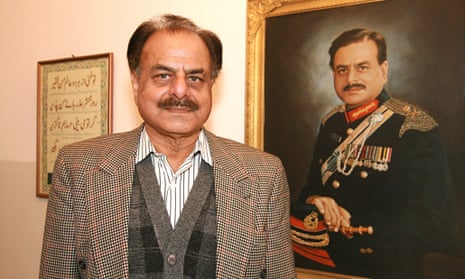Hamid Gul, who has died aged 78, led Inter-Services Intelligence (ISI), the largest of Pakistan’s intelligence agencies, for two years in the late 1980s when it played a vital role in channelling billions of dollars of American and Saudi money and armaments to jihadist groups in Afghanistan that were in the process of driving out the Soviet army of occupation. Gul worked closely with the CIA at this stage and was well enough regarded by the Americans. But he subsequently championed the Taliban, which took control in Afghanistan following the Soviet retreat, gave outspoken support for hardline Islamists in Pakistan and beyond, insisted that Israel had been responsible for the 9/11 attacks in the US and refused to accept that Osama bin Laden was other than “a romantic figure”. While winning him many admirers at home, this made him a figure of loathing in Washington.
Gul also had enemies closer to home. He was vilified in neighbouring India, where he was seen as the principal Pakistani sponsor of Muslim separatist groups and the prime supporter of pro-Pakistan militant groups in Jammu and Kashmir, the territory disputed between India and Pakistan since partition in 1947. He was reviled by secular and liberal political forces inside Pakistan, who never forgave him for “meddling in politics” in 1988, while head of ISI, by cobbling together a rightwing alliance to try to prevent Benazir Bhutto’s Pakistan Peoples party winning a general election after Gul’s mentor, the military dictator General Muhammad Zia ul-Haq, had died in a mysterious plane crash.
Bhutto became prime minister and sacked Gul the following year, which he claimed happened on “George Bush senior’s orders”. This made the rift into a gulf and Bhutto regarded the ex-intelligence chief as an inveterate plotter against her up until her assassination in 2007.
Gul was an unabashed self-publicist who, unusually for a former spymaster, cultivated the media and loved the limelight. Smartly groomed and always immaculately dressed, he was a regular guest on Pakistani news and chat shows expounding his support for Islamist movements at home and abroad and articulating his latest conspiracy theories. He made frequent appearances at political rallies held by hardline Islamist groups, and was especially prominent in the countrywide movement which helped drive from power the former military ruler General Pervez Musharraf in 2008. Gul had lambasted Musharraf for co-operating with the Americans after the 11 September attacks.
His grandstanding encouraged many in the west to believe that Gul’s support for the Taliban and other Islamic radicals was far more than just vocal. Allegations emerged in leaked US military documents in 2010 that the “jihadi spymaster” had ordered attacks against Afghan and international military forces in December 2006, that he had plotted to kidnap UN staff and had helped Taliban fighters to escape.
Gul denounced the claims of his active involvement in terrorism as “completely baseless” and sceptics questioned the sources of the allegations, but the uncertainty was enough for him to be the subject of travel bans in the US and Britain.
Gul was born in Sargodha, Punjab, in what was then British India. His father, a small farmer, had served in the British Indian army. Educated locally, then in Lahore and later at a Pakistani military academy, he was commissioned into the army in 1956. As a tank commander in the 1965 war with India over Kashmir, he was credited with contributing to a Pakistani victory at the battle of Chawinda, holding back the Indian offensive towards Sialkot. Gul’s steady rise through the ranks saw him promoted to battalion commander in 1972, brigadier in 1978 and commander of the 1st Armoured Division, Multan, in 1980. By this time, Zia had seized power, deposing the prime minister, Zulfikar Ali Bhutto, who was subsequently tried and executed. It was Zia, an admirer, who promoted Gul to the head of ISI, in March 1987.
Zia’s death in 1988 deprived Gul of his protector and he sought to shore up his position by helping organise a rightwing Islamist alliance to oppose the PPP, now led by Bhutto, in the first free elections for 11 years. Gul’s political plotting failed but his continuance at the head of ISI was a condition of the army’s acceptance of Bhutto coming to power. The relationship between the two was strained from the outset.
Initially Gul was authorised to continue the policy of backing the mujahideen in Afghanistan, with the CIA, to secure the Soviet defeat there. This goal was achieved by the completion of the Soviet withdrawal in February 1989, but within months Gul was sacked by Bhutto after the failure of a plan he was said to have drawn up to have the mujahideen capture Jalalabad in eastern Afghanistan. Gul returned to mainstream military activities but retired in 1992 rather than be shunted into less prestigious posts. However, far from being a prelude to obscurity, this was the start of two decades of high-profile political and media activity.
Gul is survived by his wife, two sons, Umar and Abdullah, and a daughter, Uzma.

Comments (…)
Sign in or create your Guardian account to join the discussion